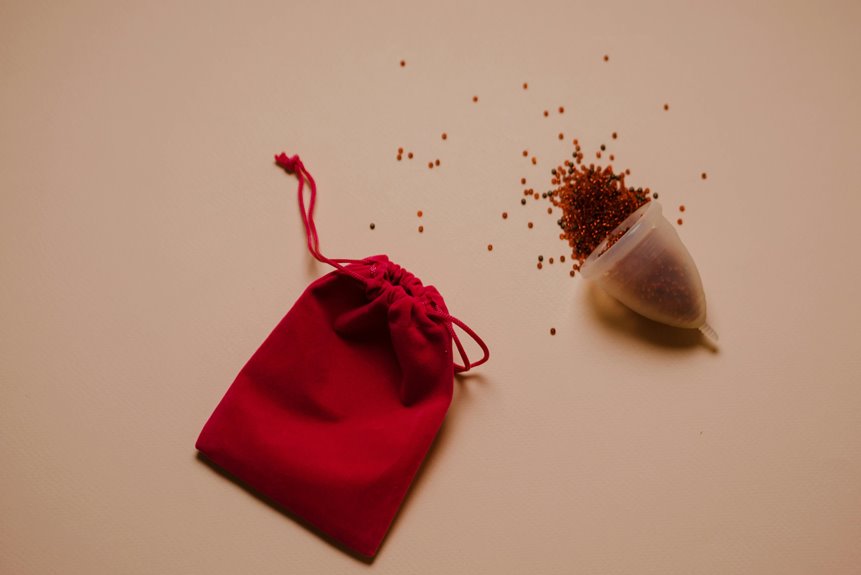When a spill happens on your velvet, act fast by gently blotting with a clean cloth—avoid rubbing to keep fibers safe. For red wine, sprinkle baking soda to absorb moisture, then let it sit; coffee needs mild soapy water for gentle cleaning, while grease calls for cornstarch to soak up oil before washing. Always test solutions on a hidden spot first, and keep velvet away from heat during drying. Learn how to tackle other common stains and protect your velvet’s lush look.
Table of Contents
Key Takeaways
- Blot velvet spills gently with a dry cloth immediately, avoiding rubbing to prevent fabric damage and stain spreading.
- For red wine stains, blot first, apply baking soda or cornstarch to absorb moisture, and avoid water or heat during treatment.
- Clean coffee stains by blotting, then gently dabbing with a mild dish soap solution, rinsing with water, and air drying.
- Treat grease stains by sprinkling cornstarch or talcum powder for 15-20 minutes before brushing off and applying mild soap if needed.
- Always test cleaning solutions on an inconspicuous area and work from the stain’s edge inward to minimize spreading.
Identifying the Type of Velvet Fabric
How can you tell what type of velvet fabric you’re dealing with? Start by checking the fabric label if you can—this usually gives you the fiber content and care instructions.
Begin by checking the fabric label to identify the velvet’s fiber content and care guidelines.
If the label’s missing, feel the texture: silk velvet feels smooth and luxurious, while cotton velvet is softer but less shiny. Synthetic velvets like polyester often have a slight sheen and feel more resistant to crushing.
You can also gently press the pile with your fingers; natural fibers typically bounce back slower than synthetics.
Another trick is to test a small hidden area with water—natural fibers absorb moisture, while synthetics repel it.
Knowing whether your velvet is silk, cotton, or synthetic helps you choose the right stain removal method without damaging the fabric.
General Tips for Stain Removal on Velvet
Once you know the type of velvet you’re working with, you can tackle stains more effectively. Start by blotting the spill gently with a clean, dry cloth—never rub, as this can damage the fabric’s pile.
Always test any cleaning solution on an inconspicuous area first to avoid discoloration. Use cold water when diluting cleaners, since hot water might set stains. Avoid soaking the velvet; instead, apply minimal moisture and blot carefully.
Work from the stain’s edge toward the center to prevent spreading. After cleaning, let the fabric air dry completely, then brush it softly with a velvet brush to restore its texture.
How to Remove Red Wine Stains From Velvet
If you spill red wine on your velvet, act quickly to prevent the stain from setting.
Blot the area gently without rubbing, then use a recommended cleaning method tailored for velvet.
Following these steps will help you restore your fabric effectively.
Immediate Actions
Because red wine can quickly set into velvet’s delicate fibers, you need to act fast to prevent a permanent stain.
First, gently blot the spill with a clean, white cloth or paper towel—never rub, as that pushes the wine deeper. Use light pressure to absorb as much liquid as possible.
Next, sprinkle a small amount of baking soda or cornstarch onto the damp area; this will help draw out moisture and color. Let it sit for at least 10 minutes before carefully brushing it off.
Avoid applying water immediately, as it may spread the stain. Finally, keep the velvet fabric flat and avoid heat or sunlight, which can set the stain.
Acting promptly with these steps increases your chances of removing the red wine without damage.
Cleaning Techniques
When tackling red wine stains on velvet, you’ll want to use gentle cleaning methods that protect the fabric’s texture. Start by blotting the stain with a clean cloth to absorb as much wine as possible. Next, mix a solution of mild dish soap and cold water. Dampen a cloth with this mixture and gently dab the stain—avoid rubbing, which can damage the velvet fibers. Afterward, use a dry cloth to blot away excess moisture. Finally, let the fabric air dry.
| Step | What to Do |
|---|---|
| Blot | Absorb wine without rubbing |
| Clean | Use mild soap and cold water |
| Dry | Air dry, avoid heat sources |
Effective Methods for Coffee Stain Removal
When coffee spills on your velvet, blot it immediately to prevent the stain from setting.
You’ll want to use gentle cleaning techniques to avoid damaging the delicate fabric.
Acting quickly and carefully makes all the difference in keeping your velvet looking fresh.
Immediate Coffee Blotting
Act quickly to blot coffee stains on velvet fabric as soon as they occur to prevent them from setting. Use a clean, dry cloth or paper towel and gently press the stain—don’t rub, or you’ll push the coffee deeper into the fibers. Repeat blotting with fresh cloths until no more coffee transfers.
Here’s a quick guide:
| Step | Action |
|---|---|
| 1. Blot | Gently press with cloth |
| 2. Replace cloth | Use a fresh cloth each time |
| 3. Avoid rubbing | Prevent spreading or damage |
Gentle Cleaning Techniques
Although coffee stains on velvet can be stubborn, you can remove them effectively by using gentle cleaning techniques that protect the delicate fabric.
Start by mixing a small amount of mild dish soap with lukewarm water. Dampen a clean, white cloth with the solution and gently blot the stained area—never rub, as this can damage the fibers.
After blotting, use another cloth dampened with plain water to remove soap residue. Pat the area dry with a soft towel, then allow it to air dry completely.
If the stain persists, consider using a velvet-safe upholstery cleaner following the product’s instructions. Always test any cleaning solution on an inconspicuous spot first to avoid discoloration.
These gentle steps help you lift coffee stains without harming your velvet fabric.
Cleaning Grease and Oil Stains on Velvet
Since grease and oil can quickly seep into velvet’s fibers, you’ll want to treat stains as soon as possible to prevent permanent damage. First, gently blot the stain with a clean cloth—never rub. Then, sprinkle cornstarch or talcum powder over the spot to absorb the oil; let it sit for 15-20 minutes before brushing it off carefully. If the stain lingers, apply a small amount of mild dish soap diluted in water and dab gently. Always test on a hidden area first to avoid discoloration.
| What You Feel | What You Want |
|---|---|
| Panic over stain | Quick, effective fix |
| Fear of damage | Gentle, safe cleaning |
| Frustration | Easy-to-follow steps |
This approach helps you save your velvet while easing worry.
Treating Ink Stains on Velvet Fabric
When ink lands on velvet, you’ll want to act quickly to prevent it from setting into the fabric. First, blot the stain gently with a clean, dry cloth to absorb as much ink as possible without rubbing it deeper.
Next, dampen a cotton swab with rubbing alcohol or an ink stain remover designed for delicate fabrics. Test it on an inconspicuous area before applying it directly to the stain.
Dab the stain carefully, working from the outside in to avoid spreading. Avoid oversaturating the velvet; use minimal moisture.
Once the ink lifts, blot with a clean cloth dampened with water to remove any residue. Let the fabric air dry completely.
If the stain persists, consider consulting a professional cleaner to protect your velvet’s texture and color.
Removing Food Stains Without Damaging Velvet
If you want to keep your velvet looking pristine, you need to treat food stains carefully and quickly.
First, gently blot the stain with a clean, dry cloth to absorb excess moisture—never rub, as this can damage the fabric’s pile.
Gently blot stains with a clean, dry cloth—avoid rubbing to protect the velvet’s delicate pile.
Next, mix a small amount of mild dish soap with lukewarm water. Dampen a soft cloth with this solution and lightly dab the stain from the outside inward. Avoid soaking the fabric.
Afterward, use a clean cloth dampened with plain water to remove soap residue. Let the velvet air dry completely, away from direct heat or sunlight.
For stubborn stains, consider using a velvet-specific cleaner or consulting a professional to avoid ruining the delicate texture.
Act promptly, and your velvet will stay spotless.
Preventative Care to Protect Velvet From Future Stains
Although velvet is a luxurious fabric, it can be surprisingly vulnerable to stains. To protect your velvet, start by applying a fabric protector spray designed for delicate materials. This creates a barrier against spills and dirt. Always test the spray on a hidden area first.
You should also avoid eating or drinking near velvet furniture to minimize accidents. Regularly vacuum your velvet with a soft brush attachment to remove dust and prevent grime buildup. Rotate cushions and avoid direct sunlight to prevent uneven wear and fading.
If you catch a spill early, blot immediately with a clean, dry cloth instead of rubbing. Taking these simple steps will help keep your velvet looking pristine and reduce the need for tough stain removal later.
Frequently Asked Questions
Can Velvet Fabric Be Machine Washed Safely?
You shouldn’t machine wash velvet fabric since it can damage the texture and cause shrinkage. Instead, spot clean or dry clean velvet to keep it looking fresh and avoid ruining its soft, luxurious feel.
How Do Professional Cleaners Handle Velvet Stains?
Like a surgeon with precision tools, professional cleaners spot-treat velvet stains using gentle solvents and specialized brushes. They avoid water, ensuring the fabric’s texture stays plush and vibrant, restoring your velvet without damage or dullness.
What Is the Best Way to Dry Velvet After Cleaning?
You should let velvet air dry naturally, avoiding direct heat or sunlight. Don’t wring or twist it; instead, gently blot excess moisture with a clean towel and keep the fabric flat to maintain its texture.
Are Steam Cleaners Safe for Velvet Fabric?
You shouldn’t use steam cleaners on velvet since they can damage its delicate fibers and cause water spots. Instead, gently spot clean with mild detergent and air dry to keep your velvet looking its best and soft.
Can Homemade Stain Removers Damage Velvet Fibers?
Oh sure, go ahead and douse your velvet with homemade stain removers—they’re practically velvet’s worst nightmare. You’ll probably ruin those delicate fibers fast. So, unless you want a sad velvet disaster, think twice before experimenting!






